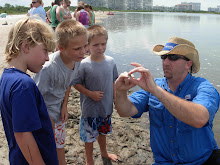 |
| Image credit:FDACS |
Did you know that 100% of the spiny lobster (Panulirus agrus) commercially harvested in the United States comes from Florida? In fact, spiny lobster is one of Florida's top seafood products in dockside value. In 2011 over 5.7 million pounds were harvested with a dockside value of over $38 million dollars!
Florida's spiny lobster fishery is concentrated mainly in South Florida, with approximately 90% of landings coming from the Florida Keys. While the fishery is jointly managed in federal waters by the Gulf of Mexico and South Atlantic Fishery Management Councils, most of the fishing effort occurs in state waters, which is managed by the Florida Fish and Wildlife Conservation Commission.
Several regulations are implemented to ensure the long-term sustainability of the fishery.
- Minimum size limits
- Closed seasons/areas
- Gear restrictions
- Trap limitation and permitting program
The commercial spiny lobster season runs August 6th through March 31st. Typically a large proportion of landings occur in the first several months of the season followed by a steady decline the rest of the season. Fishing effort, in many cases also follow this trend. For example, in October many fishermen shift to harvesting stone crab, which contribute to decreased effort.
 |
| Image credit: FDACS |
Since the 1960's Florida's spiny lobster fishery has primarily used traps to harvest the crustaceans, although some operations continue to dive for them. Lobsters are landed alive in depths from six to 300 feet.Traps are constructed of wood or plastic and can be no larger than three feet by two feet by two feet or the volumetric equivalent (12 cubic feet) with an entrance located at the top of the trap. Traps are also required to have a self-deteriorating escape panel to reduce incidents of "ghost" fishing in case the traps are lost or abandoned. Fishermen typically string traps along a trap line with each end of the line marked by a buoy. Traps, buoys, and vessels, must display a special permit number preceded by the letter "C" to denote them as commercial lobster operations.
Traps that are lost, abandoned, or incorrectly deployed can cause damage to reefs and seagrasses. To minimize these potential impacts management efforts have closed certain areas off to lobster fishing, and several organizations conduct trap clean up events to remove derelict traps off sensitive bottom habitats.
 |
| Image credit: Bryan Fluech |
Despite a large domestic fishery, imports of spiny lobster tails make up at least an order of magnitude larger than what Florida fishermen land. Shell-on, frozen lobster tails are commonly imported from Brazil, Bahamas, Nicaragua, and Honduras. In addition, a significant portion of Florida landings are also exported. International demand for spiny lobsters have increased in recent year, particularly whole, live lobsters which brings a higher price to fishermen. Lobsters are often exported to China, Japan and other Asian countries in addition to Canada, France, and other European countries.
Spiny lobster landings in the 2000's have been considerably lower than in the previous decade, but pinpointing a single cause is difficult. Many factors affect fishery recruitment including the lost of juvenile and adult habitat, changes in spawning stock and larval supply, changes in water quality, and events that can impact population dynamics such as hurricanes, algal blooms, and/or changes in oceanographic conditions. In addition PaV1, a naturally-occurring pathogenic virus that is often fatal to juvenile spiny lobster is also thought to have played a factor in these declines.
According to NOAA, the U.S. spiny lobster fishery is not undergoing overfishing nor is it overfished. However, the status of the population is unknown because larval spiny lobster in U.S. waters come mostly from multiple areas of the Caribbean Sea. Without sampling the entire Caribbean region, it is impossible to assess the local population.
 |
| Image credit: Bryan Fluech |
References:
Florida Fish and Wildlife Conservation Commission-Commercial Landings Data
NOAA-Fishwatch
http://www.fishwatch.gov/







No comments:
Post a Comment